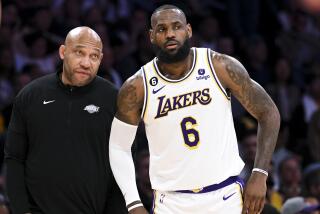Smolinski Finds Answers as Career Is Reborn in L.A.
- Share via
Bryan Smolinski has awakened from a two-year nightmare.
“It really got frustrating . . . to a point where I began to think, ‘Maybe I’m not as good,’ ” Smolinski says of his time with the New York Islanders, who traded him to the Kings in June along with winger Ziggy Palffy and backup goalie Marcel Cousineau.
“You don’t question your confidence, but maybe your ability. It makes you wonder, ‘Maybe I can’t play this game anymore.’ ”
He can play it well enough to score eight goals and chip in a team-high 24 assists, centering a line that includes wingers Donald Audette and Glen Murray. Included in that offensive aggregate are points scored in eight consecutive games, making him the most consistent King in what--with four losses in a row--has been an inconsistent time.
His lifetime best is nine games in a row, from March 7-16, 1996.
As important, though, he is playing the game well enough to foster confidence from Coach Andy Murray and teammates in his defensive ability. The barometer: When the Kings are in five-on-three penalty-killing straits, the three are Smolinski and defensemen Rob Blake and Mattias Norstrom.
When there’s an important faceoff to be won, Smolinski is sent out to win it. He has done that well enough to rank among the league leaders, winning 53%.
“Most of the time, the guy who’s a good offensive center can play offense, and that’s it,” says Blake. “ ‘Schmoe’ is a great two-way player who can kill penalties. There’s not a lot of guys like that. Ronnie Francis 1/8of the Carolina Hurricanes 3/8 is like that. 1/8Igor 3/8 Larionov of Detroit. Schmoe is of that caliber.”
Smolinski laughs. Again, there are bad memories that make what he is doing today seem even better.
“That’s funny because I never did that on the Islanders,” he says of the extra chores the Kings have given him. “They never figured I was a special-teams player. They just thought I might be a power-play player.
“But in Boston and Pittsburgh I did the same things I’m doing here. I always wondered, ‘What aren’t they seeing that better teams in the league are seeing?’ ”
The mental and emotional conflict, the crisis of confidence, are behind him, scattered among the litter of apartment leases and memories of packing and unpacking to go to a new team in a new city.
Smolinski is 27, but he’s the oldest 27-year-old extant.
Being traded, justifying the trade with performance, then being traded again will do that to a guy.
“Reputations get hung on players, whether it’s fairly or unfairly,” says Dave Taylor, the Kings’ senior vice president and general manager who engineered the trade that brought Smolinski, Palffy and Cousineau to the Kings in exchange for Josh Green, Olli Jokinen, Mathieu Biron and a first-round draft choice.
“I think Bryan Smolinski would view that as a challenge. Maybe 1/8coming to the Kings 3/8 a reprieve.”
He does.
Trades are just business, and if they are going to be part of the hockey business, so should contract negotiations. The street between player and management is two-way, and Smolinski has traveled in both directions.
“The first trade, from Boston to Pittsburgh, I wondered why,” he says. “God, I was 22 years old, I had two pretty good years and I thought Boston would be an awesome place to stick around and go pretty far in the playoffs.
“When that trade happened, it enlightened me. It happens. It’s happened to the best players in the game. It made you look at the game a little differently. Get a harder edge. There are 700 guys in the same situation.”
Smolinski had broken in by scoring 31 goals for the Bruins, then followed with 18 goals in a lockout-shortened 44-game season.
Then, two years out of Michigan State, he was out of Boston.
The deal sent him and Glen Murray to the Pittsburgh Penguins for Kevin Stevens--who later became, briefly, a King--and Shawn McEachern and was made, according to a Boston source, because the Bruins were about to open the FleetCenter and wanted a couple of local faces to promote.
OK, a trade. There are a lot of them. Taylor is the rarity: a player who was able to stay with one team throughout his career.
A year later, another deal for Smolinski, from Pittsburgh to the Islanders.
Uh-oh.
“There was an option year in my contract, and I thought it was time to renegotiate,” he says. “I scored 50-odd goals in two years 1/8including 24 in Pittsburgh, separated by the lockout-year 18 3/8. I figured I could stay in Pittsburgh a while.
“We had a great team, with Mario 1/8Lemieux 3/8 and 1/8Jaromir 3/8 Jagr, and we went to the conference finals and lost to Florida. Then again, money problems came in with the owner. I thought I was a million-dollar player at the time, that it was where I fit in on the scale.”
The Penguins, just entering the financial difficulties that would culminate in their bankruptcy, decided he fit in better on the Islanders’ scale.
Two trades in two seasons, and he was only 24.
Few burdens are heavier than potential. Everybody was looking for the 31-goal season he had as a rookie, and anything less was considered an underachievement. Underachieving players are eminently tradable to teams who are certain they can uncork the bottle of unrealized potential.
“He set a standard 1/8with 31 goals 3/8,” said Andy Murray, a big Smolinski fan even though the two clashed during training camp when the center was demoted to the fourth line briefly in an attempt to spur him--a successful attempt, it turned out.
Smolinski doesn’t understand what all the fuss is about.
“I might not have scored 30 1/8goals again 3/8, but I’ve had some chances,” he says. “During the lockout year, I scored 18 goals in 44 games. When I went to the Island, I had almost 30 goals 1/828 3/8 in 65 1/8actually 64 3/8 games in my first season.
“Then for a couple of years at the Island it didn’t happen. . . . I’ve got two great wingers here. I didn’t have that at the Island. I had young kids. I played everything. I played center, I played left wing, I played right wing, I played 1/8defense 3/8. They had so many centers and they knew I could play wing, so I played wing. I would play 10 games there and it would fizzle and they would say, ‘OK, you’re a center.’ What do you want from me?”
A return to form, which is apparently what the Kings are getting.
He and wife Julie bought a home in Manhattan Beach, in what is becoming a King enclave.
“We hadn’t bought in eight years,” he says, “but now everything has changed. Why not change our lifestyle?
” 1/8On the day of the trade 3/8, I gave the wife a hug and said, ‘This is going to be good for us.’ . . . It’s going to be a good time.”
A $1.7-million, one-year contract was easily negotiated, and he’s playing with a winning team again. Smolinski’s history has been one of postseason play. He had five goals and nine points in 13 games with the Bruins in the 1994 playoffs, the same with Pittsburgh in 18 games of the playoffs in 1996.
And he’s been on the Island, where the postseason, even Stanley Cups, are a fragrant memory.
Somebody else’s.
“I’m still young, but I’ve learned,” he says. “You’ve got to fall on your face to be able to jump up. I’ve been in a situation where you think, ‘What’s going to happen next?’ Now I know that you just don’t worry about it. You just go play the damn game and see what happens, and that’s what I’m trying to do.”
And doing it well in a career that’s being resurrected in L.A.
More to Read
Go beyond the scoreboard
Get the latest on L.A.'s teams in the daily Sports Report newsletter.
You may occasionally receive promotional content from the Los Angeles Times.






